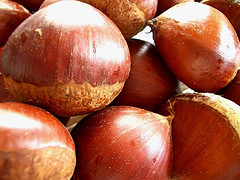Chestnuts ala Yaniger

Photo courtesy Flickr user Kanko
Nothing says fall to a Yaniger like football and chestnuts. Stuart and I did the happy dance whenever Dad returned from the Giant with a big bag of those brown nuts, because we knew the time for unabashed eating of fats and oils had arrived.
Chestnuts have a high toss rate, maybe 30% on average, at least at the MegaMart that I frequent. The chestnuts I got at the Asian grocery were much less wormy than I normally get, but the peels were much tougher, even when hot.
This was my father’s recipe, and in his honor, on the anniversary of his passing, I present the best damn way to cook chestnuts.
You will need:
* one large pot with a tight-fitting lid
* one big, sharp knife
* water
* butter
* chestnuts, about 1/2 lb per person, unless you’re a Yaniger, in which case at least 1 lb per person, after culling
Take the chestnuts and cut them almost in half, from the root to the tip, leaving a ”hinge” if possible. This is hard work, since the shells are tough, but the classic Yaniger technique is to align the thickest end of the knife along the vertical axis of the chestnut, then whack the back of the knife with the heel of the palm. If your knife is sharp, it should slice right through. Toss the halved nuts into the pot, and when there”s enough to feed the lot of you, fill the pot with just enough water to cover. Add butter, lots of it, about 4 to 6 T per pound of chestnuts. I think Dad generally put a whole stick of butter in a 3/4-full pot, which was the large Revereware pot you usually get in the full set (not the Dutch oven, the next smaller one). I think that represents around 2 lb of chestnuts. I tend to use less than that, 1 T or slightly less per pound, but I really love the taste of chestnuts alone, plus if you’ve ever seen Stuart, you know my family has a tendency to zoftigness.
Take the water, butter, chestnuts, put on high heat and bring to a boil, reduce to a simmer, cover tightly, and cook for about 20-30 minutes, or until tender. The fun of this is testing the pot every five minutes or so, checking the chestnuts by slipping one out of the buttered water, peeling it while your hands are on fire, and taking a quick peek at the doneness of the chestnut before it goes down the hatch. Eat them hot! The peels will slip off while the nuts are hot, but will become much harder to peel as they cool.
One of the real tell-tale signs of doneness is that a number of the chestnuts will have already slipped away from their shell and peel. So if you don’t care to do the hot-finger dance, consider the chestnuts done when about 1/4 to 1/2 of the chestnuts are au naturel. Don’t cook them into mush, they are really quite sweet and have a nice ”tooth” when just barely cooked through.
Happy eating this fall!
Melinda Yaniger Krummerich
Sep 28, 2001
Click to print this recipe as a PDF.